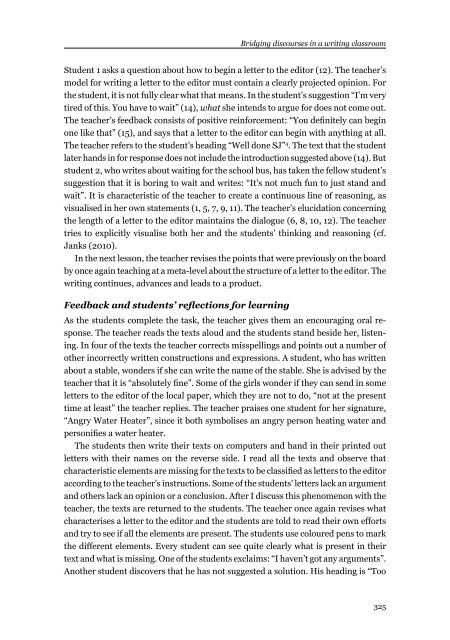Download issue - Umeå universitet
Download issue - Umeå universitet
Download issue - Umeå universitet
Create successful ePaper yourself
Turn your PDF publications into a flip-book with our unique Google optimized e-Paper software.
Bridging discourses in a writing classroom<br />
Student 1 asks a question about how to begin a letter to the editor (12). The teacher’s<br />
model for writing a letter to the editor must contain a clearly projected opinion. For<br />
the student, it is not fully clear what that means. In the student’s suggestion “I’m very<br />
tired of this. You have to wait” (14), what she intends to argue for does not come out.<br />
The teacher’s feedback consists of positive reinforcement: “You definitely can begin<br />
one like that” (15), and says that a letter to the editor can begin with anything at all.<br />
The teacher refers to the student’s heading “Well done SJ” 4 . The text that the student<br />
later hands in for response does not include the introduction suggested above (14). But<br />
student 2, who writes about waiting for the school bus, has taken the fellow student’s<br />
suggestion that it is boring to wait and writes: “It’s not much fun to just stand and<br />
wait”. It is characteristic of the teacher to create a continuous line of reasoning, as<br />
visualised in her own statements (1, 5, 7, 9, 11). The teacher’s elucidation concerning<br />
the length of a letter to the editor maintains the dialogue (6, 8, 10, 12). The teacher<br />
tries to explicitly visualise both her and the students’ thinking and reasoning (cf.<br />
Janks (2010).<br />
In the next lesson, the teacher revises the points that were previously on the board<br />
by once again teaching at a meta-level about the structure of a letter to the editor. The<br />
writing continues, advances and leads to a product.<br />
Feedback and students’ reflections for learning<br />
As the students complete the task, the teacher gives them an encouraging oral response.<br />
The teacher reads the texts aloud and the students stand beside her, listening.<br />
In four of the texts the teacher corrects misspellings and points out a number of<br />
other incorrectly written constructions and expressions. A student, who has written<br />
about a stable, wonders if she can write the name of the stable. She is advised by the<br />
teacher that it is “absolutely fine”. Some of the girls wonder if they can send in some<br />
letters to the editor of the local paper, which they are not to do, “not at the present<br />
time at least” the teacher replies. The teacher praises one student for her signature,<br />
“Angry Water Heater”, since it both symbolises an angry person heating water and<br />
personifies a water heater.<br />
The students then write their texts on computers and hand in their printed out<br />
letters with their names on the reverse side. I read all the texts and observe that<br />
characteristic elements are missing for the texts to be classified as letters to the editor<br />
according to the teacher’s instructions. Some of the students’ letters lack an argument<br />
and others lack an opinion or a conclusion. After I discuss this phenomenon with the<br />
teacher, the texts are returned to the students. The teacher once again revises what<br />
characterises a letter to the editor and the students are told to read their own efforts<br />
and try to see if all the elements are present. The students use coloured pens to mark<br />
the different elements. Every student can see quite clearly what is present in their<br />
text and what is missing. One of the students exclaims: “I haven’t got any arguments”.<br />
Another student discovers that he has not suggested a solution. His heading is “Too<br />
325

















